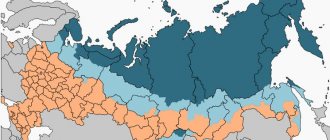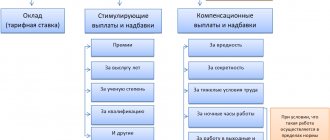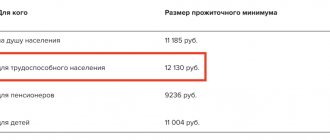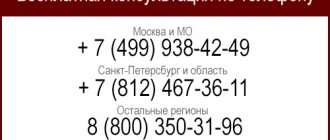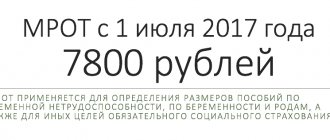The minimum wage is the minimum wage for an employee per month. In 2021, the minimum wage is 9,489 rubles, with a subsequent increase in the 3rd quarter. This value is used to regulate wages for employees, to assign benefits for temporary disability of the population, for pregnancy and childbirth, as well as to determine the amount of government fees, fines and other payments.
The minimum wage is valid throughout the Russian Federation; Regions, on their own legislative initiative, have the right to establish a higher minimum wage in their territory.
Legislative regulation of the issue
The concept of wages, as well as its components, is regulated by the norms of Article 135 of the Labor Code of the Russian Federation , which states that wages include several components.
In particular:
- salary or hourly rate;
- allowances or additional payments that are provided by law for certain categories of workers, for example, for those workers employed in hazardous work;
- incentive payments that involve bonuses, additional payments for various labor achievements or bonuses.
At the same time, salary and additional payments are mandatory components of wages, given that the conditions for their assignment, as well as the amount and timing of payment, are regulated by law, but incentive accruals are paid only based on the financial situation of the company and only if the condition for their accrual enshrined in local acts.
Also in Art. 22 of the Labor Code of the Russian Federation states that the company’s management is obliged to provide wages equal to the labor costs of employees, and for the duration of a full shift and within the scope of duties approved by the same job description and mutual cooperation agreement. And since the scale according to which the physical costs of workers are determined has not been developed, and due to the fact that many employers deliberately underestimate the level of wages, a minimum wage has been approved at the legislative level, which, in essence, acts as a guarantor of minimum material security in regarding ordinary workers.
So, in particular, Article 133 of the Labor Code of the Russian Federation states that the enterprise is obliged to pay wages not lower than the minimum wage approved by law to every worker who has worked the required hours in a month. That is, at the legislative level, based on the real subsistence level of the working population, a certain amount of material support is established, thanks to which the worker will be able to provide himself with everything necessary and below which the employer has no right to pay.
Moreover, if an employee performs his duties in conditions deviating from normal conditions, for example, in difficult climatic conditions, which is important for the northern regions, a regional coefficient is also added to the already guaranteed minimum wage in accordance with the norms enshrined in Article 316 of the Labor Code RF and in the amount approved by Law No. 4520-1.
And in accordance with Article 317 of the Labor Code of the Russian Federation, northern workers are also entitled to a bonus, calculated in proportion to the length of service in areas belonging to the far north or equivalent to it. That is, in fact, both the coefficient and the bonus for northern experience are calculated based on the accrued salary, which, in accordance with Article 135 of the Labor Code of the Russian Federation, should not be lower than the minimum wage.
Labor Law Provisions
In accordance with Part 2 of Art. 146 and art. 148 of the Labor Code of the Russian Federation, the labor of workers engaged in work in areas with special climatic conditions is paid at an increased rate; remuneration for work in such areas is made in the manner and in amounts not lower than those established by laws and other regulatory legal acts.
According to Art. 315 of the Labor Code of the Russian Federation, wages in the regions of the Far North and equivalent areas are carried out using regional coefficients and percentage increases in wages. At the same time, the size of the regional coefficient and percentage bonus, the procedure for their application for calculating the wages of employees of organizations located in the regions of the Far North and equivalent areas are established by the Government of the Russian Federation (Articles 316 - 317 of the Labor Code of the Russian Federation). In addition, state authorities of the constituent entities of the Russian Federation and local self-government bodies have the right, at the expense of funds from the budgets of the constituent entities of the Russian Federation and the budgets of municipalities, respectively, to establish higher regional coefficients for state bodies of the constituent entities of the Russian Federation, state institutions of the constituent entities of the Russian Federation, local government bodies, and municipal institutions. A regulatory legal act of a constituent entity of the Russian Federation may determine the maximum amount of increase in the regional coefficient established by the municipalities included in the constituent entity of the Russian Federation.
According to Part 1 of Art. 133 of the Labor Code of the Russian Federation, the minimum wage is established simultaneously throughout the entire territory of the Russian Federation by federal law and cannot be lower than the subsistence level of the working population. The monthly salary of a person who has fully worked the standard working hours during this period and fulfilled the labor standards (labor duties) cannot be lower than the minimum wage.
At the same time Art. 133.1 of the Labor Code of the Russian Federation provides that in a constituent entity of the Russian Federation, a regional agreement may establish the minimum wage for employees of the region, with the exception of employees of organizations financed from the federal budget.
How do these bonuses and the minimum wage interact?
Even in the process of formation, each company develops a staffing table based on the existing volume of work and the needs for employees who will perform the agreed amount of work. At the same time, when forming the terms of reference, the employer must take into account the norms of Article 195.2 of the Labor Code of the Russian Federation , which implies professional standards and ETKS, where the approximate volume of workload for each employee in the context of all positions is developed in a standard form.
Also, in accordance with Article 133 of the Labor Code of the Russian Federation, the company’s management is obliged to provide for wages not lower than the minimum wage established in Russia as a whole, as well as in most constituent entities of the Russian Federation. That is, in fact, the law provides for each worker the opportunity to receive a monthly allowance not lower than the minimum for the working population for performing duties within the limits of physical resources.
In turn, the regional coefficient has a different purpose. Thus, Article 3 of Law No. 4520-1 states that the northern coefficient applies to all types of income of citizens living in the northern regions due to the fact that the cost of living in special climatic conditions is many times more expensive in comparison with the southern regions of the Russian Federation, and Due to the northern surcharge, the ability of citizens to provide the required minimum is equalized.
For example, the range of duties of a cleaner or economist in any region of the Russian Federation will be approximately the same, as will the level of wages, but at the same time northern workers will perform their duties with a greater load due to special climatic conditions, which will lead to discrimination. That is why, for the same cleaner, a standard is provided that allows her labor costs and financial capabilities to be equalized through the application of a regional coefficient.
Approximately the same meaning is given by law to the northern bonus in accordance with Article 137 of the Labor Code of the Russian Federation, which, in essence, is financial gratitude at the state level for work experience in the northern regions. After all, working for 15 years in low temperatures with excessive physical exertion is not so easy, which is why the agreed bonus is paid to northerners.
That is, following the direct interpretation of the law, wages are remuneration for a certain amount of work performed within the standard hours per month, while the coefficient and bonus are compensation for living in special climatic conditions, implying excessive expenditure of physical strength, and material resources. And since the agreed payments have different purposes, both the bonus and the coefficient are not included in the minimum wage and are added to the already calculated wages.
Arbitrators' position
In the commentary ruling, the arbitrators noted that increased wages in connection with work in special climatic conditions should be made after determining the amount of wages, taking into account the requirement to ensure the minimum wage. This means that the regional coefficient (coefficient) and the percentage bonus accrued in connection with work in areas with special climatic conditions, in particular in the Far North and equivalent areas, cannot be included in the minimum wage. If we assume the opposite, then the monthly salary of workers who have worked their full working hours in areas with special climatic conditions would not differ from the wages of persons working in regions with a favorable climate. Thus, the guarantee of increased wages in connection with work in special climatic conditions would lose its real content.
Consequently, the regional coefficient and percentage premium must be calculated above the minimum wage for persons employed in work in areas with special climatic conditions.
Please note that this is not the only resolution. Previously, the arbitrators were of the opinion that the inclusion of a regional coefficient and percentage bonus in the minimum wage depends on the area in which the employee works:
– if he works in the regions of the Far North and equivalent areas, then the salary must be set at an amount not less than the minimum wage, after which a regional coefficient and a percentage bonus for work experience in these areas and areas must be added to it (Review of the Armed Forces of the Russian Federation dated 26.02 .2014, determinations of the Supreme Court of the Russian Federation dated July 29, 2011 No. 56-B11-10, dated June 24, 2011 No. 3-B11-16). This is due to the fact that Art. 315 of the Labor Code of the Russian Federation establishes that wages in the regions of the Far North and equivalent areas are carried out using regional coefficients and percentage increases in wages; – if he works in areas with special climatic conditions that are not related to the regions of the Far North and equivalent areas, in this case the right to increased wages established by Art. 146 Labor Code of the Russian Federation. By virtue of Art. 133 of the Labor Code of the Russian Federation, a prerequisite for calculating a monthly salary for an employee who has worked the full working hours during this period and fulfilled labor standards (labor duties) is to establish its amount not lower than the minimum wage. For these employees, the salary, including the regional coefficient and percentage bonus, exceeds the minimum wage. This means that the rights of such workers are not violated. These clarifications were presented in the Ruling of the RF Armed Forces dated 08.08.2016 No. 72-KG16-4.
Accrual procedure
Considering that the northern part of Russia is quite vast and includes many areas with different climatic conditions, the size of the coefficients has been approved at the legislative level to balance the costs of the population.
So, in particular, on average, the surcharge for special climatic conditions is a maximum of 2, which is relevant for Yakutia, the Sakhalin region and the Chukotka District, and a minimum of 1.15 in relation to such areas as Karelia.
Moreover, according to the law, the coefficient does not apply to all accruals, but only to those that are mandatory or included in the company’s remuneration system on the basis of local regulations.
In particular, the surcharge applies to the following charges:
- salary;
- compensation payments for night or overtime work;
- bonuses or bonus system.
For other accruals that imply one-time financial assistance, as well as all cases of calculating payment at an average rate, the coefficient is not applied, due to the fact that when calculating the average wage, all payments for the year with an already accrued coefficient are taken into account.
For example, an employee has a salary of 20,000 and lives in Yakutia, while he is given a bonus of 25% and 10% for hazardous working conditions. Also, in connection with family problems, the worker was given assistance in the amount of 3,000 rubles.
Then the calculation will look like this:
- 20000 * 2 = 40000;
- 20000 / 25 = 5000;
- 20000 / 10 = 2000.
Thus, the employee’s salary for the month will be: 40,000 + 5000 + 2000 + 3000 = 50,000 rubles .
For which regions are regional coefficients provided?
In order for a territory to receive a status requiring equalization of incomes of the population, it must have special difficult conditions:
- unfavorable climate;
- bad ecology;
- lack of developed infrastructure;
- dependence of the population on transport;
- the presence of organizations with difficult working conditions or special types of activities.
For officially working citizens permanently residing in such regions, the employer is obliged to make payments taking into account the coefficient
(from 1.0 to 2.0, depending on the region), applying it from the first day of their employment.
Difficult terrains include
The Far North and areas with similar climatic conditions, the Far East, the southern part of Eastern Siberia. The highest RK - 2.0 is used in Kamchatka and the Kuril Islands, the lowest 1.1 - in some areas of Kalmykia, Rostov region and Dagestan.
Sick leave payment
In accordance with Article 183 of the Labor Code of the Russian Federation, during the period of incapacity, the employee retains not only his job, but also his average salary in proportion to the length of service worked.
That is, if you have a total employment history of more than 8 years, sick leave will be paid in the amount of 100% of earnings, less than 8 years in 80% and up to 5 years in the amount of 60% of the average wage for each day of illness (Article 7 of Federal Law No. 255) .
In this case, the calculation of the average salary is carried out in accordance with Article 139 of the Labor Code of the Russian Federation, which states that all accruals for the year are taken into account, except for financial assistance, which implies the summation of salary, allowances, and the accrued coefficient. That is, in fact, when calculating the average wage, the coefficient is already taken into account initially, and for the entire past year, that is why the regional coefficient is not applied when calculating days of incapacity.
Let's sum it up
The regional coefficient is calculated for work in difficult climatic conditions. The use of the coefficient depends only on the place where the work is actually performed: if a person works in an area with a coefficient, then it is calculated from the very first day.
Difficulties may arise when calculating the regional coefficient for employees with a traveling nature of work. The detailed procedure is not specified in official documents. Therefore, when calculating the coefficient when traveling, one should proceed from the logic of each specific case.
Read also
11.11.2019
